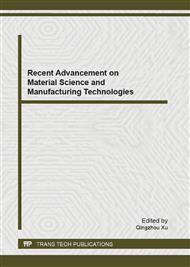[1]
Yu Jinnan.Material irradiation effect[M].Beijing:Chemical Industry Press,2007:2-4
Google Scholar
[2]
Yu Jinnan. Microstructural evolution under irradiation[J]. Chinese Journal of Nuclear science and engineering,1989,9(3):237-250
Google Scholar
[3]
Yang Wendou. The material of reactor[M].Beijing: Atomic Energy Press,2001:17-21
Google Scholar
[4]
Hofman G L,Wal Ters L C, Bauer T H. Metallic fast reactor fuel[J].Progress in nuclear energy,1997,31(1/2):83-110
DOI: 10.1016/0149-1970(96)00005-4
Google Scholar
[5]
Li Wendan,Xie Guoqiang. Modeling of physical properties for U-Pu-Zr fuel alloys[J]. Atomic Energy Science and Technology,1991,25(5):66-72
Google Scholar
[6]
Kittel J H,Frost B R T, Mustelier J P,e tal. History of fast reactor fuel development[J]. Journal of Nuclear Materials,1993,204:1-13
DOI: 10.1016/0022-3115(93)90193-3
Google Scholar
[7]
HU Yun,Xu Mi. Development of metallic fuel for fast reactor[J]. Atomic energy science and technolgy,2008,(9/42):810-815
Google Scholar
[8]
McDeavitt, Sean, et al. Thoria-Based cermet Nuclear fuel: cermet fabrication and behavior estimates, Proccedings of ICONE10. Arlington,VA:2002.4
DOI: 10.1115/icone10-22317
Google Scholar
[9]
Holden,A.N Dispersion fuel elements. New York:Gordon and breach science publishers, Inc.,(1967)
Google Scholar
[10]
Ho Jin Ryu, Young Soo Han,Jong Man Park,et al.Reaction layer growth and eaction heat of U-Mo/Al dispersion fuels uing centrifugally atomized powders[J]. Journal of Nuclear Materials, 2003,321:210-220
DOI: 10.1016/s0022-3115(03)00251-4
Google Scholar
[11]
Meyer M, Hofman G, Hayes S, et al. Low-temperature irradiation behavior of uranium-molybdenum alloy dispersion fuel[J]. Journal of Nuclear Material,2002, 304:221-236
DOI: 10.1016/s0022-3115(02)00850-4
Google Scholar
[12]
Xiao Liu, Dazhi Qian, Tiecheng Lu. The development of UMo/Al dispersion fuel[J]. Advanced Materials Research Vols 335-336(2011):1285-1292
DOI: 10.4028/www.scientific.net/amr.335-336.1285
Google Scholar
[13]
Yeon Soo Kim, G L Hofman. Effect of Si addition in Al in U-Mo/Al dispersion plates[C]. the international meeting of RRFM,2009.
Google Scholar
[14]
F.Huet, B.Guigon, P,Lemoine, et al. The UMUS failure:Fact and analyse[C]. the international of RRFM(Research Rector Fuel Management),(2003)
Google Scholar
[15]
Jiang Xin,Ding Shu-rong,Huo Yong-zhong. Finite element simulation for effective thermal conductivity coefficient of dispersion fuel element[J]. Nuclear Power Engineering, 2010,31(3):45-49
Google Scholar
[16]
LeeVanDuv, Evaluation of the mechanical behavior of a metal matrix dispersion for Plutonium[D]. Georgia Institute of Technology,(2003)
Google Scholar


